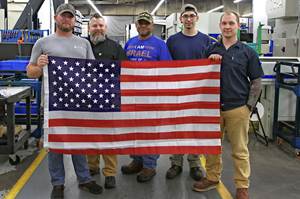It's Time to Educate the Next Generation–Manufacturing Competitions Receive Support from Companies at SkillsUSA
The depiction of manufacturing jobs as dirty and undesirable may soon be a thing of the past. How are manufacturing companies showing their interest in getting more students into the field?
Share





Without the chance to see for themselves what a job in the manufacturing sector could hold, many young people like myself (I’m 16 and completing an internship at Gardner Business Media this summer) are said to be turning their heads away from the industry entirely. According to the 2015 Skills Gap survey conducted by and , “only 37 percent of respondents in the 2015 study indicated they would encourage their children to pursue a manufacturing career,” even though most respondents agreed that manufacturing is essential to our national economy.
The prevailing perception of dirty, undesirable manufacturing jobs has harmed the desire of students to pursue an education in these sectors. Recent activities by manufacturing companies at this year’s , however, indicate that by promoting their industry they can have a positive influence on the career decisions of today’s youth.
In other words, there is hope for the manufacturing industry, and an improved perception of the skilled engineering workforce may soon engage a new generation of inspired young college graduates interested in being a part of modernized machining.
Attendees to this year’s SkillsUSA competition in Louisiville, Kentucky, may have noticed this change in action, especially in the manufacturing competitions. As a trade, manufacturing, both additive and subtractive, dominated the four-day long event in terms of monetary support and vendor representation.
I had the opportunity to attend the championship competitions at the skills conference, and I noticed that companies like Haas and Stratasys wanted the students to have the best equipment to demonstrate their skills in additive and subtractive manufacturing.
At SkillsUSA, the manufacturing and machining trades competed in skill-based competitions like metalworking, programming in G code, robotics, 3D printing, automation, CNC milling and CNC turning, to name a few. For instance, one automation competition consisted of programming a robotic arm to pick up and deposit blocks on a conveyer belt whereas one of the G-coding competitions consisted of using a CNC control to graphically create a usable code to mill a part. The majority of competitors were in high school or college, but I was surprised to hear that the youngest competitor was 13 and the oldest was 73.
On top of donating equipment for these competitions, several manufacturing companies were incentivizing competitors in the trades they were involved by offering monetary scholarships to the winners of these skill areas. As a generous donation to the competitions as a whole, the (NIMS) donated a prize of $204,000 to SkillsUSA medalists.
Manufacturing companies are realizing that the next generation of engineers and manufacturers can’t be ignored–students must be incentivized and empowered. At SkillsUSA, these companies showed that they understand the importance of stimulating a new generation.
Because of the support from manufacturing companies at SkillsUSA, students like me can see the promise of a manufacturing career.
Max Egan will be a junior at Turpin High School in Cincinnati, Ohio this fall, where he is involved in cross country, track, student council and choir. His favorite part about the internship has been the opportunity to explore the applications of manufacturing and engineering in the real world through field trips and research. When Max graduates and moves on to college, he hopes to use the skills he has learned over the summer to form the foundation for a major in mechanical or environmental engineering and delve deeper into the science of sustainability.
Related Content
Finding Skilled Labor Through Partnerships and Benefits
To combat the skilled labor shortage, this Top Shops honoree turned to partnerships and unique benefits to attract talented workers.
Read MoreIn Moldmaking, Mantle Process Addresses Lead Time and Talent Pool
A new process delivered through what looks like a standard machining center promises to streamline machining of injection mold cores and cavities and even answer the declining availability of toolmakers.
Read MoreManufacturing Technology and Training in Europe
NTMA’s European Tech Tour exposed attendees to the latest technology and traditional training methods used by European manufacturers.
Read MoreWorkholding Fixtures Save Over 4,500 Hours of Labor Annually
All World Machinery Supply designs each fixture to minimize the number of operations, resulting in reduced handling and idle spindle time.
Read MoreRead Next
AMRs Are Moving Into Manufacturing: 4 Considerations for Implementation
AMRs can provide a flexible, easy-to-use automation platform so long as manufacturers choose a suitable task and prepare their facilities.
Read MoreMachine Shop MBA
Making Chips and Modern Machine Shop are teaming up for a new podcast series called Machine Shop MBA—designed to help manufacturers measure their success against the industry’s best. Through the lens of the Top Shops benchmarking program, the series explores the KPIs that set high-performing shops apart, from machine utilization and first-pass yield to employee engagement and revenue per employee.
Read More




















